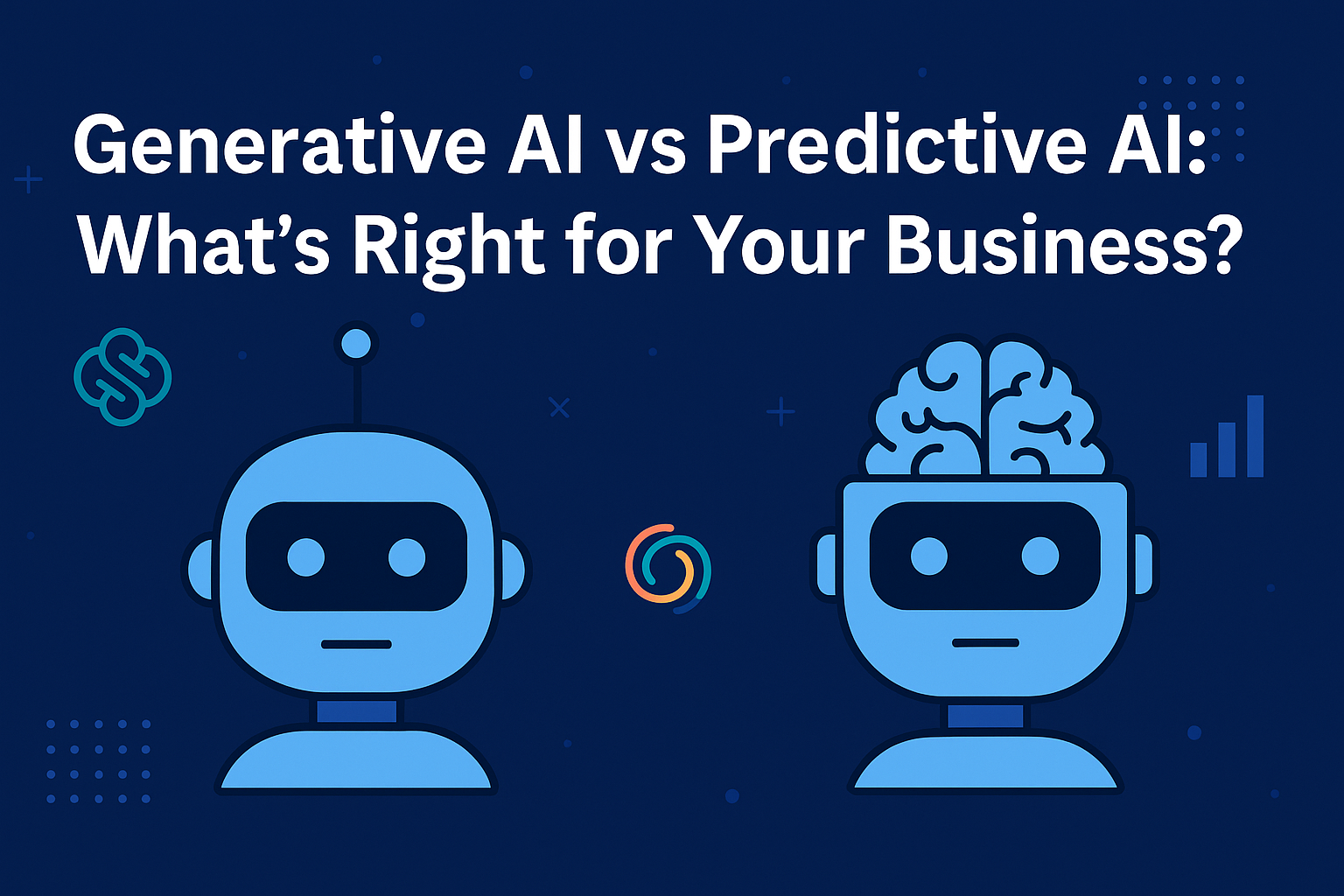
Introduction
AI isn’t just some buzzword anymore—it’s at the heart of modern enterprise innovation. But with terms like Generative AI and Predictive AI flying around, it’s easy to get lost. So what’s the actual difference? More importantly, which one does your business need? Let’s clear the fog.
What is Generative AI?
Definition & Overview
Generative AI is all about creation. It uses machine learning to generate new content—text, images, music, videos, even code. Think of it like an artist that learns from examples and creates something original.
Real-World Examples
-
ChatGPT
-
DALL·E for image generation
-
Runway ML for video editing
-
GitHub Copilot for coding assistance
How Generative AI Works
It typically uses deep learning models like Generative Adversarial Networks (GANs) or transformer architectures (like GPT or BERT). These models are trained on massive datasets and can generate outputs that mimic the patterns they’ve learned.
What is Predictive AI?
Definition & Overview
Predictive AI is like a smart analyst. It takes existing data and uses it to predict future outcomes. Whether you want to forecast sales, detect fraud, or personalize marketing—this one’s your guy.
Real-World Examples
-
Recommendation engines (Netflix, Amazon)
-
Sales forecasts
-
Fraud detection systems
-
Predictive maintenance in manufacturing
How Predictive AI Works
It uses machine learning algorithms like decision trees, regression models, or neural networks to spot patterns in historical data and predict what’s likely to happen next.
Core Differences Between Generative AI and Predictive AI
Purpose and Output
-
Generative AI creates new content.
-
Predictive AI forecasts outcomes based on patterns.
Data Dependency
-
Generative AI needs a wide range of diverse data for creativity.
-
Predictive AI thrives on clean, structured historical data.
Use Cases
-
Generative AI: Marketing content, design, AI chatbots.
-
Predictive AI: Forecasting, analytics, fraud detection.
Algorithms Behind the Scenes
-
Generative AI: GANs, Transformers
-
Predictive AI: Regression, Decision Trees, Random Forest, XGBoost
How Generative AI Can Benefit Your Enterprise
Creative Content Creation
Whether you’re generating blogs, emails, or social posts, generative AI makes content production scalable.
Product Design & Prototyping
Speed up design processes by generating multiple product ideas or concepts in minutes.
Automation and Personalization
Automate customer interactions with chatbots that talk like humans or create personalized offers using customer history.
How Predictive AI Can Benefit Your Enterprise
Forecasting & Trend Analysis
Predict demand, revenue, or customer churn before it happens and adjust your strategy in real time.
Risk Management
Spot risky transactions or operational bottlenecks before they become major issues.
Customer Behavior Insights
Learn how users interact with your product and predict what they might want next. That’s how Netflix knows what you’ll binge-watch.
When to Choose Generative AI Over Predictive AI
Business Needs & Industry Context
If your industry thrives on creativity, content, or design (think media, fashion, marketing), generative AI could be a game-changer.
Content vs Insight Focus
Need content over insights? Generative wins here.
Innovation Goals
Trying to wow your users with cutting-edge, interactive experiences? Generative AI brings the flair.
When to Choose Predictive AI Over Generative AI
Need for Accuracy and Forecasting
If your decisions depend heavily on accurate data trends—like logistics, healthcare, or finance—predictive AI is your best bet.
Data-Driven Operations
When operations rely on structured reports and decision-making, predictive AI brings clarity.
Real-Time Decision Making
Need fast, reliable output for business-critical choices? Predictive AI nails that.
Can You Use Both? Hybrid AI in Action
Complementary Power
Yes, and in fact, many top companies already do. You can generate content using generative AI and then test or optimize it using predictive models.
Examples of Hybrid Use Cases
-
A marketing team uses Generative AI to create ad copy, then Predictive AI to A/B test and refine what works.
-
E-commerce platforms generate personalized emails and use predictive analytics to time them perfectly.
Challenges & Limitations
Generative AI Limitations
-
Can hallucinate facts
-
Needs a lot of training data
-
Risk of copyright issues
Predictive AI Limitations
-
Bias in data can skew predictions
-
Struggles with creative tasks
-
Needs constant data updates
Ethical & Data Concerns
AI—both predictive and generative—must be handled responsibly. Think bias, transparency, and data privacy.
The Future of Enterprise AI
Evolving Technologies
As models evolve, the line between predictive and generative AI will blur. Think tools that can both create and analyze content.
Impact on Workforce
AI won’t replace jobs but will redefine them. Creativity and critical thinking will matter more than ever.
Strategic Planning Ahead
Smart businesses are already mapping how AI fits into their 3-to-5-year plans. Are you?
Conclusion
At the end of the day, Generative AI and Predictive AI aren’t rivals—they’re teammates. Each brings unique strengths to your enterprise toolkit. The key is knowing what you need: creation or prediction? Insight or inspiration?
Your best move? Understand your business goals, evaluate your data, and start experimenting. AI isn’t the future anymore—it’s your present.
FAQs
1. What industries benefit most from Generative AI?
Creative industries like marketing, entertainment, design, and education gain massive value from generative AI tools.
2. Can small businesses afford AI implementation?
Yes! With tools like ChatGPT, Canva AI, and cloud-based ML platforms, small businesses can get started without a massive budget.
3. Is Predictive AI more accurate than Generative AI?
Not necessarily—it’s all about the purpose. Predictive AI is designed for accuracy in forecasts, while generative AI aims for creativity.
4. How do I train AI for my enterprise?
You’ll need relevant data, the right model architecture, and a training environment—usually with help from a data science or AI team.
5. What’s the ROI on using AI in business?
Depends on your use case. Most enterprises report improved efficiency, reduced costs, and better customer engagement within months.

